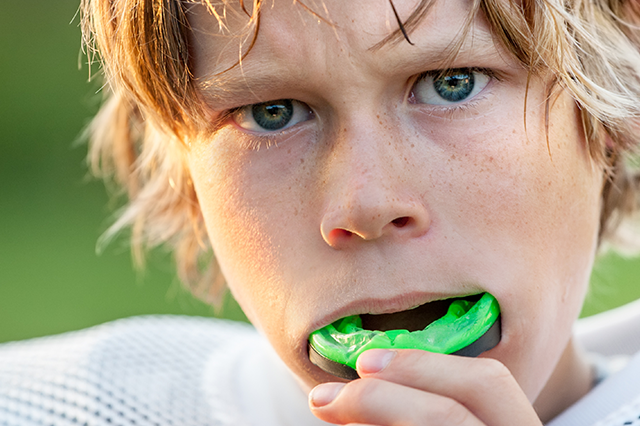Add a Sports Mouthguard to Your Back-to-School List

Summer is over, at least according to the school districts, and that means the kiddos will be starting football and other sports as well. While strains, pains, and accidents can happen and there's only so much you can do to shield your kids from them, with the right protective equipment you can rest a little easier. That being said, one of the most important parts of their protective gear is a sports mouthguard.
While they're on the field hitting and being hit by other players, there's no question that you worry about their well-being. The last thing you want is for an impact to knock out some of their permanent teeth. A properly fitted sports mouthguard can help prevent that from happening.
What is a Sports Mouthguard?
A sports mouthguard, often simply referred to as a mouthguard, is a protective device for the mouth that covers the teeth and gums to prevent and reduce injury to the teeth, arches, lips, and gums. It's a critical piece of equipment in contact sports like football, hockey, lacrosse, and soccer.
There are primarily three types of sports mouthguards:
Stock Mouthguards: These are pre-formed and ready to wear. Often found in sports retail stores, they're the least expensive but also the least comfortable and protective. They might not fit well and could make breathing and talking difficult.
Boil and Bite Mouthguards: Also available at many sporting goods stores, these mouthguards are made from thermoplastic material, which is placed in hot water to soften, then placed in the mouth allowing it to adapt to the shape of the mouth and teeth.
Custom-fitted Mouthguards: These are individually designed and made in a dental office or a professional laboratory based on your dentist's instructions. They provide the most comfortable fit, best protection, and highest durability.
Why a Sports Mouthguard Should Be on Your Back-to-School List
According to the American Dental Association, an estimated 10-20% of all sports-related injuries are maxillofacial injuries. It is reported that sports activities contribute to approximately 36% of all unintentional injuries to children and adolescents. Of these, oral and dental injuries stand as a significant part.
The National Youth Sports Safety Foundation predicted that more than 3 million teeth would be knocked out in youth sports events. However, the use of a sports mouthguard can significantly reduce the risk of sport-related dental injuries. The American Dental Association estimates that mouthguards prevent approximately 200,000 oral injuries each year in high school and collegiate football alone.
These statistics highlight the vital role of sports mouthguards in protecting young athletes from dental injuries. By absorbing and distributing the forces that can cause dental injury, sports mouthguards are an essential component of athletic gear for any child participating in sports activities.
Choosing the Right Mouthguard
When selecting a sports mouthguard, there are several factors to take into account:
Fit: As discussed earlier, a well-fitting mouthguard provides the best protection. A custom-fitted mouthguard, though more expensive, ensures a snug fit that won't slip during a game.
Comfort: A mouthguard should be comfortable enough to allow easy talking and breathing.
Durability: Look for a mouthguard that can withstand the rigorous demands of your child's particular sport.
Easy to Clean: Hygiene is crucial when it comes to oral equipment.
Remember, the key to any mouthguard is that it’s worn consistently, so be sure to choose one that your child finds comfortable and is willing to wear every time they play.
Cleaning and Maintaining Your Sports Mouthguard
Maintaining a clean mouthguard is essential not only for your oral health but also for the longevity of the mouthguard. Here are some tips:
- Clean your sports mouthguard after each use. Rinse it under cold water and use a toothbrush with toothpaste to clean the crevices.
- Once a week, soak your mouthguard in a mouthwash solution. This will help kill bacteria and leave the mouthguard minty fresh.
- Always dry your mouthguard before storing it. Bacteria thrive in damp conditions, and allowing your mouthguard to dry will help to reduce bacterial growth.
- Store your mouthguard in a ventilated plastic case. This helps reduce the chance of bacterial growth and protects it from physical damage.
- Regularly check your mouthguard for wear and tear. A damaged or ill-fitting mouthguard will not provide optimal protection.
Remember to replace your sports mouthguard after each sports season, or sooner if it becomes worn out or doesn't fit well anymore. This is important over time, as the protective qualities of the mouthguard may degrade.
Sports mouthguards play a crucial role in protecting athletes from serious dental injuries. They're particularly significant for children and adolescents, who are at a high risk of experiencing such injuries. Investing in a high-quality, durable, and comfortable sports mouthguard – and maintaining it properly – should be a top priority for anyone involved in high-impact sports.
Contact us today with questions about your family’s dental needs.